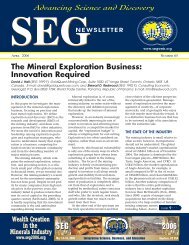Stewart R. Wallace — 1919–2009 - Society of Economic Geologists
Stewart R. Wallace — 1919–2009 - Society of Economic Geologists
Stewart R. Wallace — 1919–2009 - Society of Economic Geologists
Create successful ePaper yourself
Turn your PDF publications into a flip-book with our unique Google optimized e-Paper software.
14 SEG NEWSLETTER No 78 JULY 2009<br />
... from 13<br />
Discovery and Geology <strong>of</strong> the PGE Deposits <strong>of</strong> the Bushveld Complex, South Africa (Continued)<br />
plateau and coastal lowlands). In contrast,<br />
the western and northern limbs<br />
are covered by thick soils on the<br />
Highveld. Knowledge <strong>of</strong> these areas is<br />
largely based on mining activity and<br />
extensive drilling programs, most<br />
notably in the western limb, where mining<br />
has revealed details <strong>of</strong> some <strong>of</strong> the<br />
economic reefs over many tens <strong>of</strong> kilometers.<br />
Despite excellent overviews <strong>of</strong><br />
the Rustenburg Layered Suite (Wager<br />
and Brown, 1968; Von Gruenewaldt et<br />
al., 1985) our understanding is inhibited<br />
by subjective interpretion <strong>of</strong> field<br />
relationships between widely separated<br />
chambers which are unlikely to be<br />
interconnected.<br />
The eastern and western limbs are<br />
subdivided into sectors on the basis <strong>of</strong><br />
regional differences in the stratigraphy,<br />
although this has never been formalized.<br />
Sectors are separated by structurally<br />
complex boundary areas.<br />
Regular changes in the stratigraphy <strong>of</strong><br />
the southern sector <strong>of</strong> the western limb<br />
led Eales et al. (1988) to recognize different<br />
facies (broadly referred to as<br />
proximal and distal) on the basis <strong>of</strong><br />
(theoretical) feeder localities. This interpretation<br />
is probably widely applicable<br />
and can assist with our understanding<br />
<strong>of</strong> similarities between, for example, the<br />
distal components <strong>of</strong> both the western<br />
and eastern limbs. Sectors are further<br />
subdivided into subchambers, typically<br />
from detailed knowledge <strong>of</strong> chromitite<br />
layers and PGE reefs. In the northern<br />
sector <strong>of</strong> the western limb, for example,<br />
the Union (Viljoen et al., 1986a) and<br />
Amandelbult (Viljoen et al., 1986b)<br />
mines comprise discrete subchambers.<br />
Facies changes may in part be ascribed<br />
to synBushveld tectonism (Scoon and<br />
Teigler, 1994), despite a conflict with a<br />
widely held belief that layered intrusions<br />
occur in stable continental settings<br />
(e.g., Irvine, 1982). Structural disruptions<br />
in the Bushveld include<br />
diapirism <strong>of</strong> the floor rocks (Uken and<br />
Watkeys, 1997), and development <strong>of</strong><br />
the Rustenburg Layered Suite on the<br />
flanks <strong>of</strong> domes was influenced by associated<br />
episodic uplift (Scoon, 2002). This<br />
is ascribed to multiple phases <strong>of</strong><br />
magma replenishment<strong>—</strong>an important<br />
tenet <strong>of</strong> our understanding <strong>of</strong> the<br />
Rustenburg Layered Suite, as proposed<br />
and discussed by Eales et al. (1988).<br />
The Rustenburg Layered Suite attains<br />
a maximum thickness <strong>of</strong> some 9 to 12<br />
km within the western and eastern<br />
limbs, whereas the sequence in the<br />
northern limb is significantly truncated.<br />
On a smaller scale, each sector (and<br />
each subchamber) reveals considerable<br />
variability (South African Committee<br />
for Stratigraphy, 1980). The unconformable<br />
relationship with the floor<br />
rocks, which is most apparent in the<br />
eastern limb (Sharpe, 1981), results in<br />
the lowermost parts <strong>of</strong> the Suite<br />
sequence being spatially restricted in<br />
their development, with only the uppermost<br />
layers being laterally extensive.<br />
Various parental magma types have<br />
been identified to explain the development<br />
<strong>of</strong> the Suite (e.g., Eales, 2002),<br />
over and above the effects <strong>of</strong> upward<br />
fractional crystallization (Wager and<br />
Brown, 1968), although the mechanisms<br />
<strong>of</strong> magma intrusion are poorly<br />
constrained. Scoon and Teigler (1994)<br />
and Uken and Watkeys (1997) suggested<br />
that the thermal and loading<br />
effects <strong>of</strong> new influxes are important in<br />
enhancing floor rock irregularities,<br />
which must be accounted<br />
for in the interpretation <strong>of</strong> lateral<br />
variations between sectors<br />
and subchambers.<br />
The Rustenburg Layered<br />
Suite is subdivided into zones<br />
on the basis <strong>of</strong> a repetitive<br />
cyclicity and laterally extensive<br />
marker layers (Fig. 3). The Mar -<br />
ginal zone consists <strong>of</strong> relatively<br />
fine grained norite and feldspathic<br />
pyroxenite with little discernible<br />
layering. The Lower<br />
zone is almost entirely ultramafic<br />
and is dominated by layers<br />
<strong>of</strong> dunite, harzburgite, and<br />
orthopyroxenite. It is the<br />
Critical zone (Hall, 1932), however,<br />
that reveals the most spectacular<br />
layering and contains<br />
the PGE deposits and chromitite<br />
layers. The modern practice is<br />
to recognize a Lower Critical<br />
zone, dominated by feldspathic<br />
orthopyroxenite, and an Upper<br />
Critical zone, with more complex<br />
layering <strong>of</strong> lithological<br />
units, typically including feldspathic<br />
orthopyroxenite and<br />
norite-anorthosite. Chromitite<br />
layers, which are a defining<br />
characteristic <strong>of</strong> both the Upper<br />
and Lower Critical zones, are<br />
subdivided into Lower, Middle,<br />
and Upper groups. Chromite<br />
mining is mostly concentrated<br />
on the somewhat higher grade layers in<br />
the Lower Critical zone and lower parts<br />
<strong>of</strong> the Upper Critical zone (Schurmann<br />
et al., 1998). The Main zone that overlies<br />
the Critical zone is characterized by<br />
relatively monotonous sequences <strong>of</strong><br />
norite and gabbronorite, albeit with<br />
prominent layers <strong>of</strong> anorthosite. The<br />
Upper zone includes numerous Ti magnetite<br />
layers intercalated with magnetite<br />
gabbro, anorthosite, and ferrodiorite.<br />
PLATINUM DISCOVERIES<br />
Details <strong>of</strong> the original discoveries <strong>of</strong><br />
platinum are summarized here from<br />
the review by Scoon and Mitchell<br />
(2004a), which in turn was based on<br />
articles and editorial comments in the<br />
popular mining press <strong>of</strong> the time (e.g.,<br />
Merensky, 1925), as well as on a biog -<br />
raphy <strong>of</strong> Hans Merensky (Fig. 4) by<br />
Lehmann (1955). Exploration started<br />
FIGURE 3. Generalized vertical section <strong>of</strong> the layered<br />
sequence from the eastern limb <strong>of</strong> the<br />
Bushveld Complex, depicting zonal subdivisions<br />
and important marker layers.






